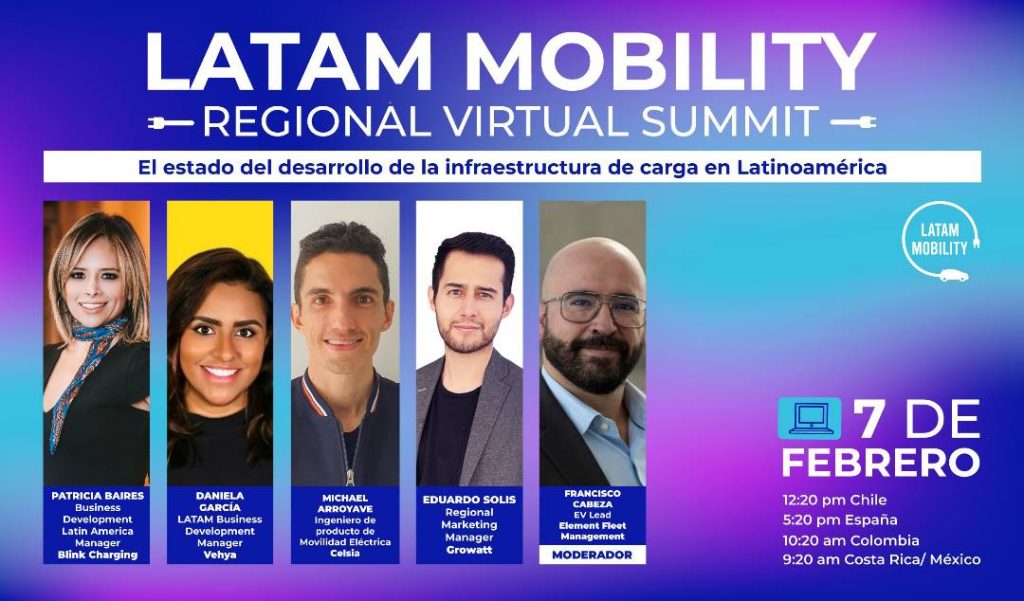Electric mobility is a reality present in several parts of the world that will have to be adopted in large proportions as the years go by, since the Paris Agreement establishes reaching zero emissions by 2050.
However, there is no point in having an electric vehicle at home if the necessary charging infrastructure is not in place, since consumers will wonder where to refuel energy or how far to go, generating doubts and negatively influencing them not to be part of the energy transition.
In this sense, Latam Mobility developed the Regional Virtual Summit 2023 with the aim of discussing sustainable mobility, being the state of development of charging infrastructure in Latin America one of the key topics of the meeting.
For this purpose, a panel of experts was formed by Patricia Baires, Business Development Latin America Manager of Blink Charging; Daniela García, LATAM Business Development Manager of Vehya; Michael Arroyave, Electric Mobility Product Engineer of Celsia, and Eduardo Figueroa, Regional Marketing Manager of Growatt, who spoke under the moderation of Francisco Cabeza, EV Lead of Element Fleet Management.
Related content: “Latam Mobility Regional Virtual Summit”: Copec Voltex Presents Wide Range of Solutions to Boost Electromobility
Understanding the Market
Daniela García, Executive of Vehya, a workflow platform that provides verified professionals for the installation and service of sustainability products, such as electric vehicle chargers, pointed out the importance of knowing the market in order to correctly adapt to the needs of each country, and even the region.
The market needs to adapt to its customers across the mobility ecosystem. Having a single standard would be a key step for the advancement of charging infrastructure, facilitating the implementation of advances. “For example, in Brazil the power output changes by department (province or state),” Garcia assured to highlight the different regulations or types of chargers that may exist.
“In our company we have operations in Brazil, Chile, Mexico, Colombia, Argentina and Uruguay. Therefore, the company’s experience has led us to understand that each market in Latin America is different.”
In addition, Vehya is prepared for what is to come. “We are ready to embrace the whole part of the charging infrastructure with the objective of contributing to a society capable of having the necessary electrical assistance,” he commented.
Now, while charging infrastructure is necessary, the company stresses the importance of people as essential agents for the development of this aspect of electric mobility. Taking into account this factor together with the various standards and requirements, a set of actions to develop charging infrastructures in Latin America can be properly addressed.

Policies and Requirements
Patricia Baires, representative of Blink Charging, a company born in the United States with 13 years of experience in the market and presence in 28 countries, including a good number in Latin America, highlighted key elements that the company performs, in addition to raising the importance of knowing the policies and requirements of each country.
The executive pointed out that the information provided by the organization will be “very well used and understood with greater openness than a year ago” given that at that time the market was taking its first steps in terms of shippers.
“We want and we are going to contribute to new markets to know electromobility and to have charging stations that can be smart. We are in the process of teaching how to do business from electromobility, because you can have an economic return from it,” she assured.
She also pointed out that one of the main purposes and foundations they have for this year as a company is to help establish new recharging corridors. However, the outlook still has some way to go in that regard.
“This year is full of challenges, of learning, of understanding Latin America and its legislation policies, that is key to be able to take development to another level,” she said.
She also explained that one of the great challenges for the industry in terms of cargo infrastructure is to provide high technological development in exchange for good prices for consumers.
“In Latin America we have different cargo ports. Therefore, it is vital to have the diversity that can be covered to meet all the needs in different places, giving the market the requirements of each country and complying with the legislation of each country”.
Priority to Fast Charging
Eduardo Figueroa, executive of Growatt, a company dedicated to creating smart energy solutions with the presence of its products in Latin America and the world, stressed the importance of having a variety of chargers on the market.
In addition, the organization he represents has been known for working in the solar sector, although for years they have also been dedicated to the energy section, such as vehicle charging infrastructure, contributing their grain of sand in the growth of this sector.
“What we are currently doing is making this connection of solar and renewable energy to be able to charge our electric vehicles. That mix that we make through hardware and software together with the proposal that we bring to Latin America, where we have DC, AC and fast charging chargers, is part of our contribution to electrified mobility”.
On the other hand, he commented on a work of analysis that the company performs in relation to the various connectors that are available in each market. “In Mexico, for example, we have the American connector, European and even from China,” Figueroa states to expose the difficulty this poses at the time of boosting the massive development of electric vehicle chargers.
“We are starting to see that it is no longer only the use of type 1 or AC chargers, as in Brazil and Mexico we observe that the market for fast charging chargers (type 3) is growing, which is positive, given that the charging time greatly influences the decision of users to take an electric car home,” he pointed out.
In this sense, promoting this type of chargers will be one of the activities that must be carried out to boost electric mobility through an appropriate charging infrastructure that meets the needs of consumers.
Greater Role in Latin America
Michael Arroyave, executive of Celsia, an energy sector company headquartered in Colombia with operations in Panama, Costa Rica and Honduras, outlined the greater prominence that Latin America has achieved in terms of sustainable mobility, encompassing charging infrastructure as a pillar.
“The panorama has changed in relation to Latin America. Colombia and Chile were practically the undisputed leaders in this sector. Now, other nations are joining, such as Brazil and Mexico, which have ‘woken up’ after obtaining large numbers of electric vehicle sales, and will surely continue to spread to other nations, such as Costa Rica and Uruguay, for example,” he said.
He also commented that one of the most important changes evidenced in the industry has been the request for faster chargers by customers. “They need loads of half an hour or an hour to make the business as productive as possible,” he said, highlighting the importance of investing in this type of chargers in order to promote the development of cargo infrastructure in the region.
On the other hand, he commented that one of Celsia’s contributions in this area has been the investment in the infrastructure of AC chargers, manufacturing in Colombia several versions of them. “We sell and install several chargers of all powers (slow or fast), in addition to supporting our customers in large bus and truck fleet projects, and we are even venturing into some projects for electric cab fleets,” he said.
Finally, the company has its own charger management system with monitoring to follow in an adjusted way the operation of the devices, being key to obtain information and process it for the advancement and development of the sector.







